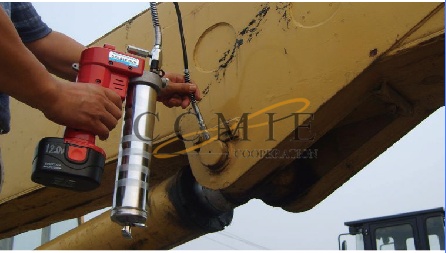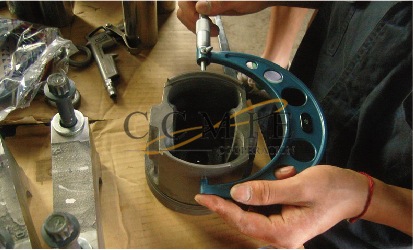1. Only add oil but don’t change it
Engine oil is indispensable in the use of diesel engines. It mainly plays lubrication, cooling, cleaning and other functions. Therefore, many drivers will check the amount of lubricating oil and add it according to standards, but they neglect to check the quality of lubricating oil and replace the deteriorated oil, resulting in some engine moving parts always being poorly lubricated. Operating in the environment will accelerate the wear of various parts. Under normal circumstances, the loss of engine oil is not large, but it is easily contaminated, thus losing the role of protecting the diesel engine. During the operation of a diesel engine, many contaminants (soot, carbon deposits and scale deposits generated by incomplete combustion of fuel, etc.) will enter the engine oil. For new or overhauled machinery, there will be more impurities after trial operation. If you rush to put it into use without replacing it, it can easily cause accidents such as burning tiles and holding the shaft. In addition, even if the engine oil is replaced, some drivers, due to lack of maintenance experience or trying to save trouble, will not thoroughly clean the oil passages during replacement, leaving mechanical impurities still remaining in the oil pan and oil passages.
2. Indiscriminate use and smearing of butter
Grease the cylinder gasket. Butter is a commonly used grease in the repair of construction machinery, which can play a role in lubrication and sealing. Therefore, some repairmen will apply a layer of butter on the cylinder gasket when installing it, thinking that this can increase the sealing of the diesel engine. As everyone knows, doing so will affect the performance of the diesel engine.
The cylinder gasket is the most important seal between the diesel engine cylinder block and cylinder head. It can not only seal the high temperature and high pressure gas generated in the cylinder, but also seal the cooling water and lubricating oil in the cylinder head and cylinder body. Therefore, in When disassembling and installing the cylinder gasket, pay special attention to its sealing quality. If you apply butter on the cylinder gasket during installation, when the cylinder head bolts are tightened, part of the butter will be squeezed into the cylinder water passage and oil passage. When the cylinder is operating, part of the butter left between the cylinder gasket will flow out due to the high temperature. When the cylinder is burned, the other part remains on the joint surface of the cylinder block and the cylinder head, causing gaps between the cylinder gasket, the cylinder head and the plane of the body. High-temperature and high-pressure gas can easily impact the cylinder gasket from here, destroying the cylinder gasket and causing leakage. gas. In addition, when butter is exposed to high temperature for a long time, it will also produce carbon deposits, causing premature aging and deterioration of the cylinder gasket. Therefore do not apply butter when installing the head gasket.
3. New cylinder liners and pistons can be installed without optional accessories.
When replacing the cylinder liner and piston, it is considered that the new cylinder liner and piston are standard parts and are interchangeable, and they can be used as soon as they are installed. In fact, the dimensions of the cylinder liner and piston have a certain tolerance range. If the largest size cylinder liner is matched with the smallest size piston, the matching gap will be too large, resulting in weak compression and difficulty in starting.
Therefore, when replacing, you must check the size grouping codes of the standard cylinder liner and piston. The cylinder liner and piston used must make the size grouping code of the standard piston and the standard cylinder liner the same. Only in this way can the difference between the two be guaranteed. Has standard fit clearance. In addition, when installing cylinder liners and pistons with the same group code in each cylinder, attention should also be paid to inspecting the cylinder plug clearance before installation. In order to ensure assembly standards, an inspection should be conducted before installation to prevent the installation of fake and inferior products. .
4. Cylinder clearance measurement is inaccurate
When measuring the cylinder clearance, it is not possible to measure in the direction of the piston skirt perpendicular to the piston pin hole, but in other directions. The structural characteristics of the aluminum alloy piston are that the top is small and the bottom is large, it is a cone, and the skirt section is oval, so the cylinder gaps along the circumferential direction are not equal. When measuring, it is stipulated that the gap in the direction of the long axis of the ellipse shall be taken as the criterion, that is, the gap in the direction of the piston skirt perpendicular to the direction of the piston pin hole shall be measured. This measurement is more convenient and accurate, and during reciprocating motion, the direction of the piston skirt perpendicular to the piston pin hole is subject to greater wear due to the lateral pressure. Therefore, when measuring the cylinder clearance, the piston skirt should be perpendicular to the piston. Pin hole direction measurement.
5. Piston heated by open flame
Since the piston and piston pin have an interference fit, when installing the piston pin, the piston should be heated and expanded first. At this time, some maintenance personnel will place the piston on an open flame to heat it directly. This approach is very wrong, because the thickness of each part of the piston is uneven, and the degree of thermal expansion and contraction will be different. Open flame heating will cause the piston to be heated unevenly and easily cause deformation; charcoal ash will also adhere to the surface of the piston, reducing the strength of the piston. service life. If the piston cools naturally after reaching a certain temperature, its metallographic structure will be damaged and its wear resistance will be greatly reduced, and its service life will also be significantly shortened. When installing the piston pin, the piston can be placed in hot oil and heated evenly to cause it to expand slowly. Do not use an open flame for direct heating.
Post time: Feb-22-2024


